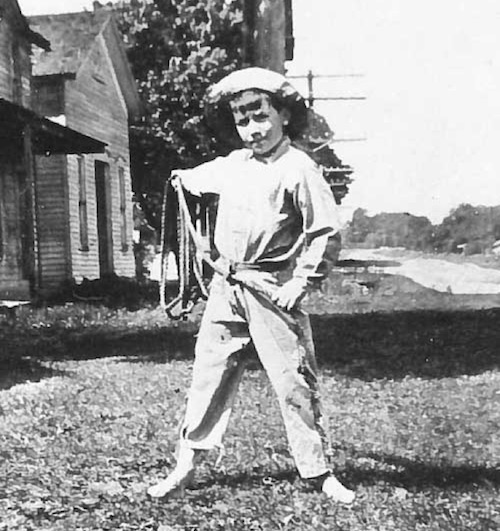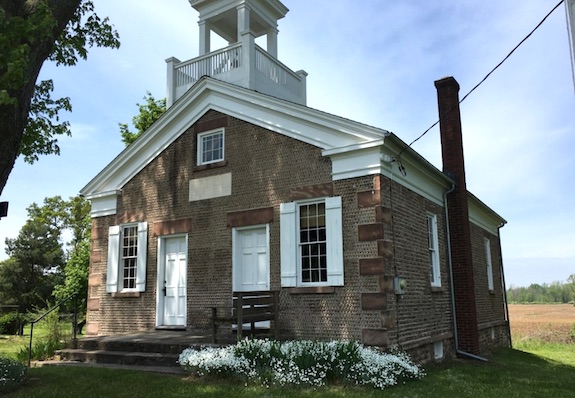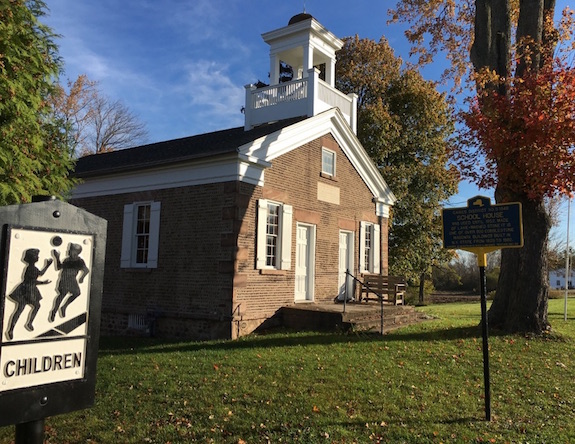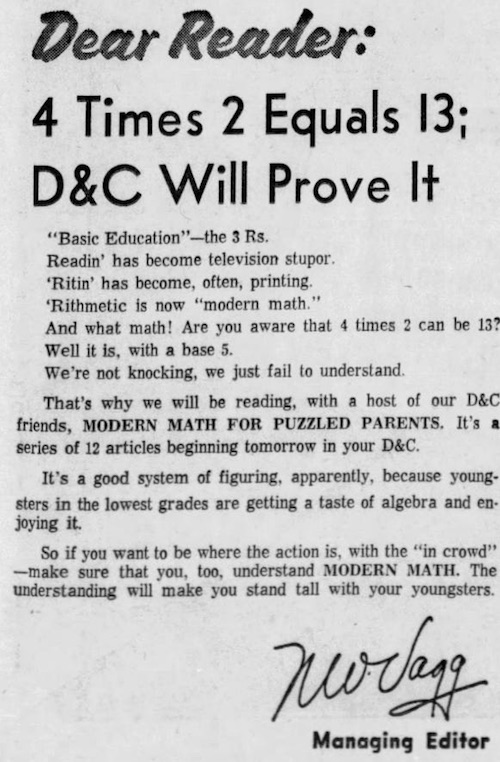Historic Childs: Norris Vagg served Rochester as prominent newspaper executive
By Doug Farley, Cobblestone Museum Director
Norris Wilbur Vagg, born on October 25, 1903, grew up in the Hamlet of Childs, the son of Joseph and Nellie Vagg who owned and operated the blacksmith shop at Childs during the first half of the 20th century.
Norris’ sister, Melva (Warner) Vagg rounded out the family of four who lived in the house next to the blacksmith shop at the south west corner of the intersection in the Hamlet. The story of Norris Vagg’s life may have had an inauspicious beginning to be sure, but an early appreciation for the subtleties of spelling and the English language would propel him on a lifelong career that would take him to one of the highest offices of the region’s foremost newspaper.
Like all children in the Hamlet of Childs in the early 1900s, Norris attended the Cobblestone District No. 5 School just up the road from his home. His written reflection on a one-room schoolhouse education follows:
“It had no swimming pool, no gymnasium, not even inside plumbing, but the old cobblestone District No. 5 one-room schoolhouse was a place of learning. We didn’t start French or Spanish in third grade, but we did learn to read, write and spell English. We had Christmas and Easter vacations and sometimes took time to plant a tree on Arbor Day, but the rest of the time we LEARNED.
We learned to concentrate while other classes recited. Our work done, we learned by osmosis and eavesdropping when those other reciting grades were more advanced than ours. I learned you could make money writing by winning a countywide Women’s Christian Temperance Union (WCTU) essay contest, and I learned you could lose it by missing one word of 500 in a similar spelling contest.
No gymnasium? The entire outdoors (for a 15 minutes recess) was there for baseball, wrestling, foot-racing, and acrobatics on the ledge halfway up the cobblestone walls or a bicycle rodeo for the admiring girls. Teachers didn’t interfere nor referee unless blood-letting started.
Teaching was tutoring, because each of us had individual attention I wouldn’t trade a moment of it for the mad rush of buses, hurrying through crowed corridors, cafeteria rowdyism and the impersonality of 25-in-a-centralized-one-grade schoolroom today. But then, like District 5, perhaps I’m old beyond my time.”
Winning spelling and essay contests in grade school were certainly a harbinger of big things to come in the life of this local boy. After completing his early education and graduating from Albion High School, he matriculated at the University of Rochester in 1922.

Norris Vagg, family photo 1920s
Norris Vagg’s enjoyment of countless baseball games played during recess at the cobblestone schoolhouse and later at Albion High School, actually earned him the Varsity Shortstop position on the U of R team.
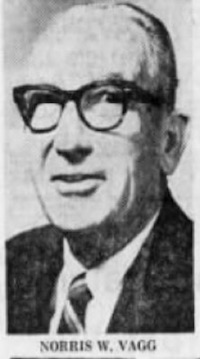
Norris, called “Red” by his friends and associates, soon advanced to the Assistant to the Western New York Editor. From the Vicinity Desk he moved to the City Desk as a Staff Reporter. Later, he was Assistant to the Financial Editor, a Copyreader and Makeup Editor.
In 1934, Vagg was named Day City Editor. Three years later he took over the Night City Editor desk. In 1942, Vagg became head of the Copy Desk and a year later News Editor, also serving as Sunday Editor. He was named Assisting Managing Editor in 1949. In 1960 at the age of 56, thirty-eight years after starting work at the Democrat & Chronicle, Norris Vagg became the paper’s Managing Editor, a positon he held until his retirement in 1968.
Throughout his many years at the newspaper, Norris wrote and supervised the writing of thousands of articles. It has been said he looked for a little humor in every situation, as demonstrated in the following article in 1966 that described a parent’s dilemma with Modern Math.
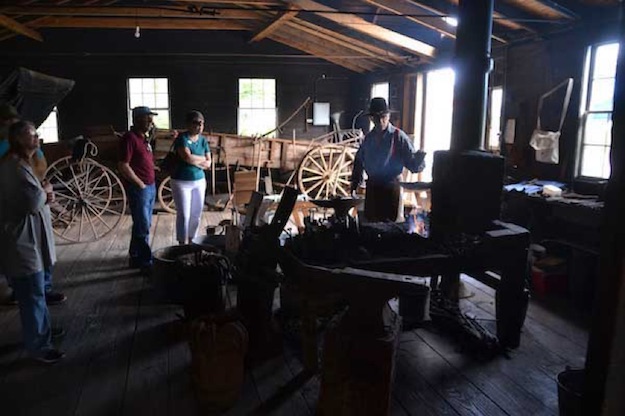
Henry Ott demonstrates the forge at the Vagg Blacksmith Shop in 2018
Even though Rochester became his home, Norris Vagg maintained his strong feelings for the Hamlet of Childs and the little blacksmith shop that had formed the basis for much of his early life. His Father, Joseph, operated the community’s blacksmith shop until his death in 1956. The author, Arch Merrill, described Joseph Vagg as “the last of the blacksmiths along the Ridge.” Norris reflected on life as a blacksmith’s son, and the tragic fire that disrupted the pace of the Hamlet in 1921.
“Still half asleep, I jumped from bed as ‘red Daylight’ filled my second floor bedroom, reflection of raging flames consuming Dad’s original blacksmith shop at Childs, about 20 feet from our house.
Sleep was brief that fall night as my sister Melva and I had attended a dance at Co. F Armey in Medina, fighting fog coming home on my first effort at night driving without adult support. Rest of that night was spent watching firemen protect the house and sitting alongside the shop ruins with Dad until nearly daylight.
Other crowding recollection include help farmers gave Dad in rebuilding; Mother helping in the shop until I developed muscled enough for some assistance; hot, rainy muggy days when farmers couldn’t work outside but could overfill the shop with horses and give themselves a holiday gabfest, and how Dad could disperse conversationalists crowding too close with a well-directed shower of sparks as he welded calks to shoes.
And most valuable, perhaps, was the lesson in clear, succinct communication administered by Dad after I had trained at the anvil and proudly showed off my educated observations in sizing horseshoes as he worked the floor by asking: ‘5s or 6s, Dad?’ His invariable answer: ‘Yes’. ”
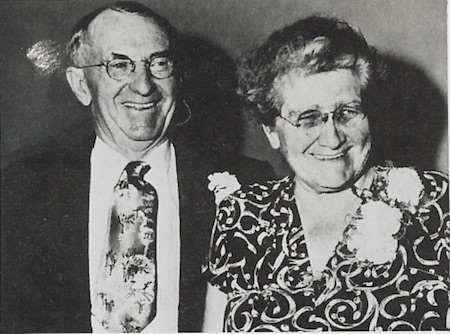
Joseph & Nellie Vagg, 45th Anniversary Celebration, 1948
Norris’ mother, Nellie, made arrangements to give the blacksmith shop to the Cobblestone Museum in the event of her death so that people for all times could see sparks fly out of the open door, and hear the sound of the anvil, and feel the heat of the forge. That transfer of ownership took place following Nellies death in 1975, and the Cobblestone Museum held a Dedication Service on May 28, 1978. Norris and several Vagg family members attended the dedication. At that service, Norris’ sister, Melva, remarked:
“My fondest memory of the blacksmith shop was watching the sparks fly as my Dad shaped the red hot irons on the anvil. The only work I remember doing was bolting the steel tires to the buggy wheel rims. We often worked by lantern light in to the late evening. My brother and I didn’t realize we were being supervised. We thought we were helping and I guess we were. The work I remember best was washing the dishes in the house so my Mother could give Dad some real help. Those were the days of happy memories.”
Norris Vagg, a favored son of the Hamlet of Childs, died on December 30, 1985 at the age of 82, in Henrietta, NY, after losing a 12 year battle with Lou Gehrig’s Disease. At the time of his death, his fellow journalists at the Democrat & Chronicle described him as, “One of the finest people I know in the newspaper business.”
Another spoke of his 46 year newspaper career, “He worked his way up from copyboy to managing editor, and held every job in-between.” His daughter-in-law, perhaps summed it up best. “The newspaper was his life!”
















